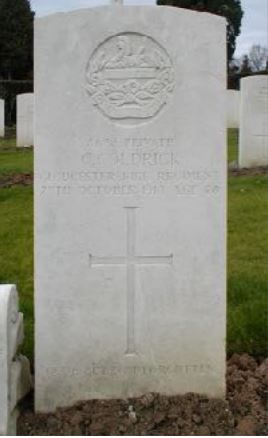2nd Battalion, Gloucestershire Regiment

Charles Coldrick was born in the St Mark’s Parish of Gloucester in 1889. He was the son of Thomas and Mary Coldrick, who had twelve children, ten of who survived up to the time of the 1911 Census. Thomas’ occupation was a plasterer and he died in 1910.
On 20 January 1908 Charles enlisted into the Gloucestershire Regiment at Bristol, at the age of 19 years and five months. He signed on for seven years with the Colours and a further five with the Reserve.
He was initially posted to the Depot and transferred to the 2nd Battalion on 16 April 1908. His next posting, to the 1st Battalion, coincided with a move to India on 3 November 1908 and he was to remain there until 24 November 1910. From 25 November 1910 until 25 September 1913 he was located at Cambridge Barracks, Portsmouth and thereafter at Bordon Camp until the battalion was posted to France on 13 August 1914. He was wounded in action during the British Expeditionary Force (BEF) Retreat from Mons and was in hospital at Wimereux on 31 October 1914, having been wounded in the right side. The wound was probably the reason for his return to the UK on 6 November 1914 and placement on the Depot roll. The Gloucestershire Echo of 29 December 1914 reported his inclusion in the 23 November official casualty list. On 12 March 1915 he was posted to the 2nd Battalion, serving in France with the BEF. On 25 November 1915 the 2nd Battalion was posted to Salonika, northern Greece, as part of the Mediterranean Expeditionary Force, which was part of an Anglo-French force facing the Bulgarians. They embarked that day from Marseilles and arrived at Salonika on 12 December 1915.
Charles fell seriously ill in Salonika. In May 1916 he had a seizure, fell and when picked up discovered that he was unable to move his left arm and leg and his speech was badly affected. Upon admission to No 20 Stationary Hospital on 26 May it was thought he had suffered thrombosis and was marked as ‘dangerously ill’. He was considered out of danger on 3 June but on 12 July he had arrived at Valetta Military Hospital, Malta, where hemiplegia (paralysis of one side of body) was diagnosed. This condition was normally due to a brain lesion, tumour or a stroke. He was returned to the UK and arrived at the 2nd Western General Hospital, Manchester on 28 July 1916. He was to remain there until he was discharged from the Army as ‘no longer physically fit for war service’.
A medical board on 20 November 1916 declared that his condition had barely improved since his return to the UK and he was now having to walk with the aid of a stick. It was considered that his condition was a result of active service and climatic conditions and as a result a permanent pension was granted, subject to periodic review and a Silver War Badge (denoting military service undertaken) was issued. The address on his discharge papers was shown as 7 Fox Elms Road, Tuffley, Gloucester.
Charles Coldrick died on 28 October 1918, aged 28. The Gloucestershire Journal of 2 November 1918 carried a notice of death, stating that this occurred at Fulham Road, London, the deceased being a resident of Hare Lane, Gloucester. He was buried in Gloucester Old Cemetery, where a CWGC headstone marks his grave and he is commemorated on the Gloucester City War Memorial.
Researched by Graham Adams 24 January 2016
